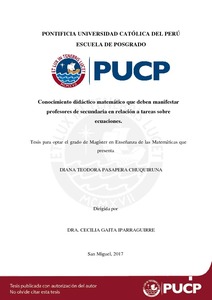| dc.contributor.advisor | Gaita Iparraguirre, Rosa Cecilia | |
| dc.contributor.author | Pasapera Chuquiruna, Diana Teodora | es_ES |
| dc.date.accessioned | 2017-07-19T17:45:35Z | es_ES |
| dc.date.available | 2017-07-19T17:45:35Z | es_ES |
| dc.date.created | 2017 | es_ES |
| dc.date.issued | 2017-07-19 | es_ES |
| dc.identifier.uri | http://hdl.handle.net/20.500.12404/9106 | |
| dc.description.abstract | El presente trabajo de investigación tiene como objetivo identificar el conocimiento didáctico
matemático que debe manifestar un profesor en la secundaria para reconocer la complejidad o la
progresión de características algebraicas en tareas sobre ecuaciones que se presentan en textos escolares.
Para ello, señalaremos cuáles son los conocimientos matemáticos referidos a cada objeto primario
asociado a las ecuaciones de primer y segundo grado que emergen de las prácticas matemáticas, en una
propuesta para el significado institucional de referencia de las ecuaciones.
A partir de dicha propuesta y de las consignas que se describen para la faceta epistémica y ecológica
del Modelo del Conocimiento Didáctico Matemático propuesto por Godino (2009), hemos llegado a
determinar que un profesor debe ser capaz de identificar los conocimientos que se requieren para abordar
un contenido, así como los lenguajes, conceptos, tipos de situaciones, diferentes procedimientos y
propiedades que se ponen en juego para el estudio de las ecuaciones. También las conexiones de las
ecuaciones de primer y segundo grado con temas y tópicos más avanzados según el currículo nacional.
Además, debe identificar los conocimientos que marquen la evolución del razonamiento algebraico
elemental, tales como el reconocimiento de los procesos algebraicos de generalización, unitarización,
simbolización que son rasgos característicos de los niveles de algebrización (0, 1, 2 y 3) que se definen
desde el enfoque ontosemiótico de la cognición e instrucción matemática (EOS) para que genere o
modifique tareas en mejora de su práctica profesional.
Finalmente, en nuestras consideraciones finales, destacamos que con la identificación de estos
conocimientos y el insumo del significado institucional de referencia será posible dar cuentas en futuras
investigaciones de las ausencias, presencias, debilidades y fortalezas de nuestro diseño curricular; así
como de implementar una propuesta para formación de profesores. | es_ES |
| dc.description.abstract | The present research aims to identify the mathematical didactic knowledge that must be demonstrated
by a teacher in the secondary to recognize the complexity or progression of algebraic characteristics in
tasks on equations that are presented in school texts. To do this, we will point out the mathematical
knowledge related to each primary object associated to the first and second degree equations that emerge
from the mathematical practices, in a proposal for the institutional meaning of reference of the equations.
Based on this proposal and the slogans that are described for the epistemic and ecological facet of the
Mathematical Didactic Knowledge Model proposed by Godino (2009), we have come to determine that
a teacher must be able to identify the knowledge required to approach A content, as well as the
languages, concepts, types of situations, different procedures and properties that are put into play for the
study of the equations. Also the connections of the first and second degree equations with topics and
more advanced topics according to the national curriculum.
In addition, it must identify the knowledge that marks the evolution of elementary algebraic reasoning,
such as the recognition of the algebraic processes of generalization, unitarization, symbolization that are
characteristic features of algebrization levels (0, 1, 2 and 3) that are defined from the ontosemiotic
approach of cognition and mathematical instruction (EOS) to generate or modify tasks in improving
their professional practice.
Finally, in our final considerations, we emphasize that with the identification of this knowledge and the
input of the institutional meaning of reference, it will be possible to account for future investigations of
the absences, presences, weaknesses and strengths of our curricular design; As well as to implement a
proposal for teacher training. | es_ES |
| dc.language.iso | spa | es_ES |
| dc.publisher | Pontificia Universidad Católica del Perú | es_ES |
| dc.rights | Atribución-NoComercial-SinDerivadas 2.5 Perú | * |
| dc.rights | info:eu-repo/semantics/openAccess | es_ES |
| dc.rights.uri | http://creativecommons.org/licenses/by-nc-nd/2.5/pe/ | * |
| dc.subject | Matemáticas--Estudio y enseñanza (Secundaria) | es_ES |
| dc.subject | Álgebra--Estudio y enseñanza | es_ES |
| dc.title | Conocimiento didáctico matemático que deben manifestar profesores de secundaria en relación a tareas sobre ecuaciones | es_ES |
| dc.type | info:eu-repo/semantics/masterThesis | es_ES |
| thesis.degree.name | Maestro en la enseñanza de las Matemáticas | es_ES |
| thesis.degree.level | Maestría | es_ES |
| thesis.degree.grantor | Pontificia Universidad Católica del Perú. Escuela de Posgrado | es_ES |
| thesis.degree.discipline | Enseñanza de las Matemáticas | es_ES |
| renati.discipline | 199117 | es_ES |
| renati.level | https://purl.org/pe-repo/renati/level#maestro | es_ES |
| renati.type | http://purl.org/pe-repo/renati/type#tesis | es_ES |
| dc.publisher.country | PE | es_ES |
| dc.subject.ocde | https://purl.org/pe-repo/ocde/ford#5.03.01 | es_ES |






